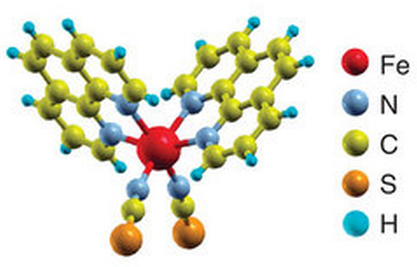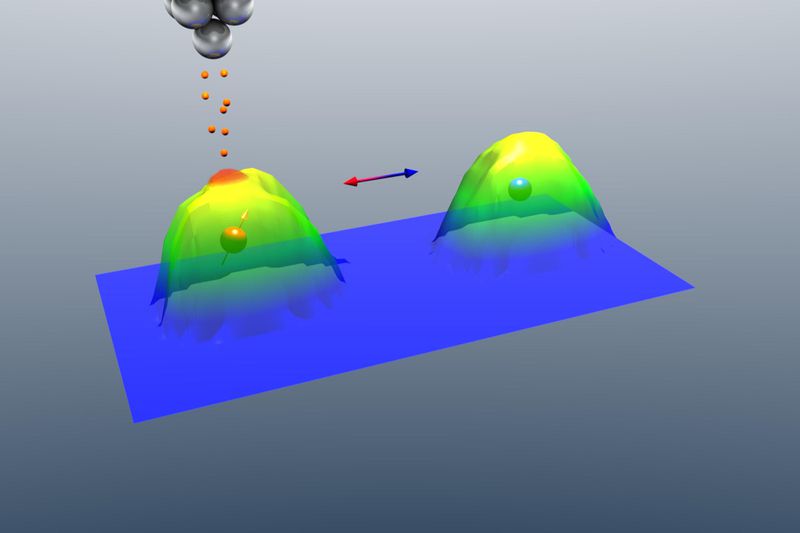One bit - one molecule
Even as a tenth grade student, scratching the next hard drive with a “asterisk” screwdriver (by the way, why do hdd be called so?), Many thoughts came up about how to make the recording more dense. Not knowing at the time about the supermagnetic effect, but already knowing that the atom is divisible, I figured out what the theoretical limit of information density is when writing to a tangible medium. Now it does not seem so funny.
Approximately three million atoms of magnetic material store 1 bit of information in modern hard drives. German researchers from Karlsruhe and Strasbourg, together with Japanese researchers from Chiba University, developed a new type of memristor magnetic memory, which is capable of storing one bit of information within one molecule of magnetic matter, the so-called molecular magnet.

')
“The superparamagnetic effect prevents further reduction of the size of one bit on the surface of the hard disk plates,” says Toshio Miyamachi, a scientist from the Center for Functional Nanostructures (CFN) of the Karlsruhe Institute of Technology (Karlsruhe Institute of Technology, KIT). “This superparamagnetic effect is that when crystals of a magnetic substance shrink in size, they become susceptible to heat, which causes a spontaneous switching of their magnetic state. We used a completely different approach and placed a single magnetic iron atom in the center of an organic molecule consisting of 51 atoms. The organic envelope protects information stored in the central iron atom from external influences. ”
In addition to an incredible information storage density of one bit per molecule, the new type of memory, based on the effect of “spin crossover molecules”, has a simple procedure for recording and reading information. Using a pulse of electric current of a certain shape and size, an organic-metal magnetic molecule can be switched to a conducting, magnetic state, and to a non-conducting, non-magnetic state.
“Using a scanning tunneling microscope, we applied an electrical impulse with certain characteristics exactly to a molecule about nanometer in size,” said Wulf Wulfhekel, a scientist who led the research group at the KIT Physikalisches Institut Institute. “The electrical impulse changed not only the magnetic state of the iron atom, but also the electrical properties of the molecule as a whole.”

Thus, the two magnetic states of the iron atom lead to different electrical conductivities of the entire molecule, which can be measured quite simply by measuring electrical resistance. “These memristor and spintronic properties, realized in the framework of one molecule, open up completely new areas for further research,” the researchers are convinced. Let me remind you that a memristor is a type of memory that stores information in the form of a change in the electrical resistance of a conductor from a special material. Spintronics uses for storing and processing information of the back, the torques of individual particles, atoms and molecules.
Original source: www.kurzweilai.net/a-magnetic-memory-with-one-bit-per-molecule# ! PrettyPhoto
Approximately three million atoms of magnetic material store 1 bit of information in modern hard drives. German researchers from Karlsruhe and Strasbourg, together with Japanese researchers from Chiba University, developed a new type of memristor magnetic memory, which is capable of storing one bit of information within one molecule of magnetic matter, the so-called molecular magnet.

')
“The superparamagnetic effect prevents further reduction of the size of one bit on the surface of the hard disk plates,” says Toshio Miyamachi, a scientist from the Center for Functional Nanostructures (CFN) of the Karlsruhe Institute of Technology (Karlsruhe Institute of Technology, KIT). “This superparamagnetic effect is that when crystals of a magnetic substance shrink in size, they become susceptible to heat, which causes a spontaneous switching of their magnetic state. We used a completely different approach and placed a single magnetic iron atom in the center of an organic molecule consisting of 51 atoms. The organic envelope protects information stored in the central iron atom from external influences. ”
In addition to an incredible information storage density of one bit per molecule, the new type of memory, based on the effect of “spin crossover molecules”, has a simple procedure for recording and reading information. Using a pulse of electric current of a certain shape and size, an organic-metal magnetic molecule can be switched to a conducting, magnetic state, and to a non-conducting, non-magnetic state.
“Using a scanning tunneling microscope, we applied an electrical impulse with certain characteristics exactly to a molecule about nanometer in size,” said Wulf Wulfhekel, a scientist who led the research group at the KIT Physikalisches Institut Institute. “The electrical impulse changed not only the magnetic state of the iron atom, but also the electrical properties of the molecule as a whole.”

Thus, the two magnetic states of the iron atom lead to different electrical conductivities of the entire molecule, which can be measured quite simply by measuring electrical resistance. “These memristor and spintronic properties, realized in the framework of one molecule, open up completely new areas for further research,” the researchers are convinced. Let me remind you that a memristor is a type of memory that stores information in the form of a change in the electrical resistance of a conductor from a special material. Spintronics uses for storing and processing information of the back, the torques of individual particles, atoms and molecules.
Original source: www.kurzweilai.net/a-magnetic-memory-with-one-bit-per-molecule# ! PrettyPhoto
Source: https://habr.com/ru/post/147436/
All Articles